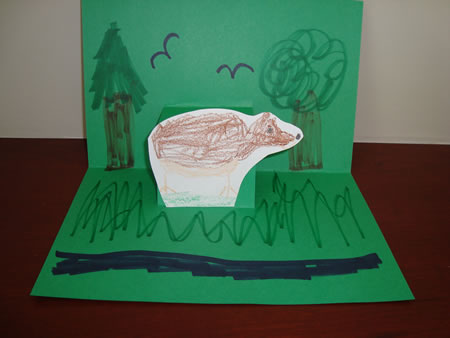Oh, give me a home, (Pretend to strum a guitar as you sing this song.)
A dry desert home,
Where the sun shines most every day.
Cacti and yucca plants,
Lizards, camels and ants -
Call the desert habitat home.
Oh give me a home,
A tropical home,
Where it rains almost every day.
Vines, ferns, and green trees,
Parrots and chimpanzees -
Call the rainforest habitat home.
Oh give me a home,
A white arctic home,
Where it’s icy and cold every day.
Polar bears, caribou,
Walrus, seals, and whales, too -
Call the arctic habitat home.
Oh give me a home,
A tall woodlands home,
Where the trees stand strong every day.
Maples, oaks, elms, and deer,
Birds and squirrels all live here -
They call the woodlands habitat home.
Home, sweet habitat homes,
Where the plants and the animals roam.
They’re comfortable here
Anytime of the year -
They’re adapted to their habitat homes.
Activities:
• What kind of habitat do you live in? What do you like about it? What do you dislike about it? What do you think would be the best habitat to live in? Why?
• Use an attribute web to brainstorm animals that you would find in different habitats.
• Divide a sheet of paper into fourths and label it with “desert,” “arctic, “woodland,” and “rainforest.” Provide children with books where they can do “research” and then draw animals that they might find in the various habitats.
• Make pop-ups of animals that you would find in different habitats. Cut a sheet of paper in half. Fold each section in half. Cut two 1 slits on the crease as shown. Bend in the tab. Write the name of a habitat on the front of the pop-up. Give children construction paper scraps and let them draw and cut out animals they might find in that habitat. Glue the animal to the tab and then ask the children to color the rest of the scene to resemble the habitat.
• Take three sheets of paper 6” x 6” and tape them together to make a tri-fold. Have the children think of a habitat and then close their eyes and imagine what it would look like. Next, ask them to draw the habitat on the tri-fold. Give them play dough, pipe cleaners, and other scrap materials to create animals for their habitat.
• What is adaptation? How do animals adapt to their habitats? Can children think of animals whose colors help them blend with their environment to protect them? Have children draw a picture of one of these animals and then try to “camouflage” it on their papers.
• Cut up yarn or construction paper in 3” x 1/2” strips. Use red, blue, orange, brown, yellow, green, purple, and black colors. These will be your “worms.” Count out 25 of each color. Mark off a designated area on the playground and then scatter the “worms” all around as the children close their eyes. First call out “red worms” and the children gather up all the red strips. Count. Call out the remaining colors one at a time and count the number that you find. What color was easiest to find? Why? What colors were the most difficult to find? Why?
|

